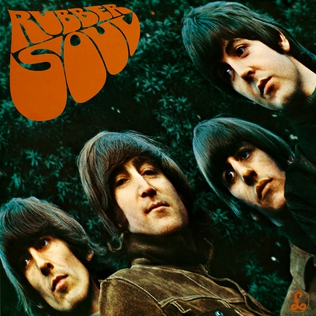IMPACTFUL ALBUMS DAY 1
No artist/group has had a more profound long-term influence on my musical sensibilities than the Beatles. There’s also no denying my attraction to acts that share musical DNA with and/or owe debts to the “Fab Four.” But what album had the biggest impact? That’s a tough pick. No single, specific Beatles album stands alone as my favorite-ist favorite. But, all things considered, Rubber Soul probably played a bigger role than any other LP in hooking me on British rock for life.
Rediscovering Rubber Soul
Until recent years, I’d always assumed that my childhood indoctrination to the Beatles was limited to old 45s, Detroit rock oldies radio, and the ’60s cartoon; not the proper albums. In my late-teens, I acquired Sgt. Peppers; then, in my early-20s, added Magical Mystery Tour, Revolver, and Rubber Soul. But these albums received little play because my listening queue was overcrowded with other, more (relatively) recent music. Then I got older. Over the last fifteen years or so, growing feelings of alienation toward contemporary pop and rock forms prompted me to gradually shift focus back to the music I heard as a child; intentionally filling gaps in my collection with music from the ’50s, ’60s and ’70s. Naturally, I started with the Beatles 2009 remastered stereo U.K. cd set.
All the Beatles studio albums (and the included Past Masters non-album single collections) re-ignited warm fuzzy feelings from childhood, but one disc stood apart; inducing a heightened, disorienting state of deja vu. I didn’t just know every word and note from every song on Rubber Soul by heart. I knew the play order, as well. That kind of imprint only comes with strict repetition. Somehow, I heard this album many, many times as a young child. It had to have been among the records my eldest siblings regularly borrowed from Nana and Pap Pap’s.
Why Rubber Soul is Special
The Beatles’ knack for writing genuine pop hooks and melodies was present from the beginning and they experienced exponential growth as songwriters, players, singers, and arrangers with each successive album. Nevertheless, their sixth LP, Rubber Soul, represented a bold step forward for the group.
First, the record ended their practice of padding track listings with obligatory, albeit enjoyable, American r&b, rock, and pop covers. Thus, all fourteen of the golden slabs featured are original compositions credited to John Lennon/Paul McCartney and George Harrison. Second, while early Beatles albums generally played like random collections of singles, the track listing on Rubber Soul sounds intentional. The record takes the listener on a genuine journey. Each song flows naturally into the next; each song provides a complimentary musical counter-point to those around it.
Starting a psychedelic journey
Also, while each of their albums were adventurous in their way, Rubber Soul clearly points toward the psychedelic revolution that soon followed. True, nothing here plays as dramatically trippy as “Tomorrow Never Knows” from its follow-up, Revolver, but the journey begins here.
Rubber Soul’s masterfully crafted, acid-tinged album cover provides the first hints that the Beatles had entered their psychedelic phase. The downright groovy, muted orange, curvilinear, hand-drawn title design in the upper-left corner contrasts strongly with the conventional blocky fonts used on all their prior U.K. releases. Also, the slanted camera attitude of the cover photo presents a less straight-forward image of the group. Accentuating the feeling that the boys had, perhaps, ascended to another level of consciousness, the subtly distorted photo is shot from below eye-level and treated with a green filter. Additionally, the image they project is less buttoned-up than in the past. Their trademark mop-tops are noticeably longer; matching suits and ties traded for unmatched, informal brown and black jackets and turtlenecks.
Musically, signs of their growing psych-leanings are evident in the deep-grooves on the riffing lead track “Drive My Car” and the driving proto-hippie anthem “The Word.” But that’s not all! Dig the formidably fuzzy guitar licks on “Think For Yourself.” Sit anywhere and ponder the gentle acoustic ballad “Norwegian Wood (This Bird Has Flown)” as it mixes free-spirited beatnik imagery with exotic east-Indian instrumentation. Was this the first appearance of a sitar on a Beatles album? I think it was!
WHat else goes on
Let’s see… What other developments are going on here…? The melancholy moods that seasoned the group’s musical stew since Beatles For Sale continue on “Nowhere Man” and “Girl.” Harrison’s chiming 12-string folk rocker “If I Needed Someone” would’ve sounded right at home on the Byrds Mr. Tambourine Man (that’s a compliment, btw). The Beatles also wonderfully continue their tradition of heartfelt, reflective love songs with “In My Life” and “Michelle.”
Lastly, Rubber Soul showcases the Beatles’ talent for disguising dark/difficult lyrical themes in catchy sing-along tunes. I find this particularly interesting because the trait is unusually common among my favorite songwriters (Andy Partridge/Colin Moulding; Elvis Costello; James Mercer). Each case is one of a relationship that’s gone awry. On “I’m Looking Through You,” Macca sings of disillusionment with a “girl” he no longer holds up on a pedestal. “You Won’t See Me” has him describing the pain of having been cut-off completely. Ringo Starr laments his “girl’s” unfaithfulness on the country number “What Goes On.” Predicting the band’s impending retirement from live performance, Lennon’s anxious vocal on “Wait” has him returning to a partner/lover after a long time away, seemingly unsure of what will greet him when he gets there.
Twisting the tone from anxious to outright menacing, the lyric for the memorable album closer “Run For Your Life” portrays Lennon as an unhinged abuser who’d rather see his “little girl” dead “than to be with another man.” That’s about as dark as it gets folks, but I dare you to not sing along. Like everything else here, it’s an absolute earworm.
